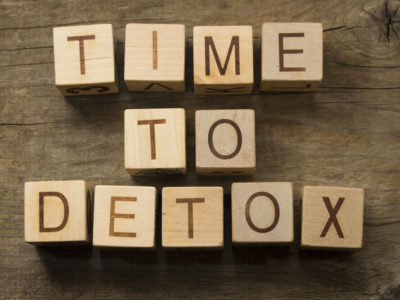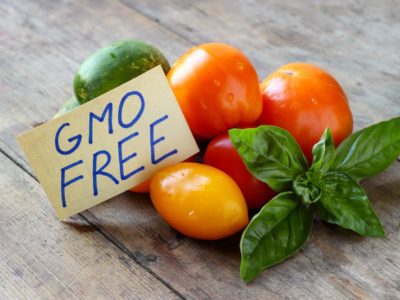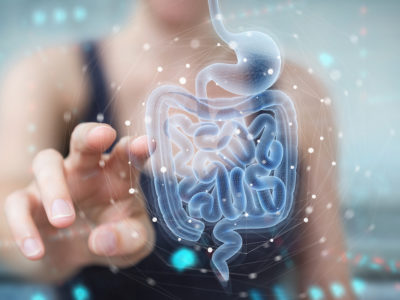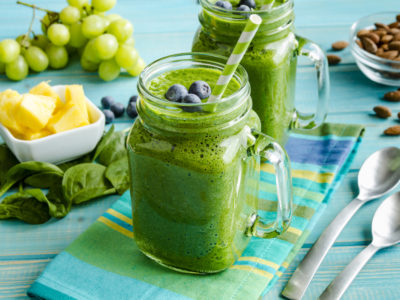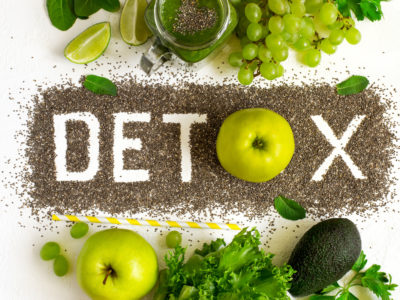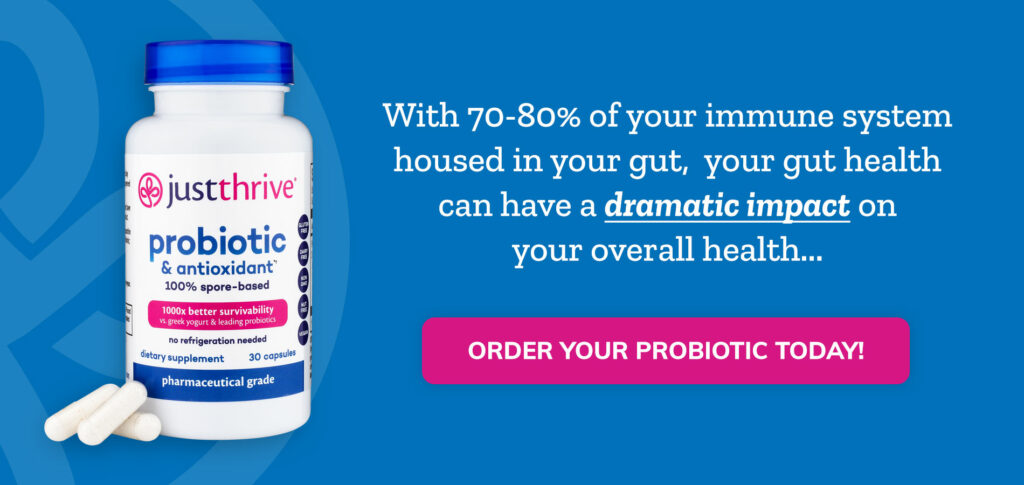Table of Contents[Hide][Show]
How to Detox Your Body+−
- 1. Drink More Water
- 2. Clean Up Your Diet
- GMO Scandal: Why You Should Avoid Genetically Modified Food
- 3. Explore Detoxifying Herbs & Supplements
- 4. Eat Foods High in Sulfur
- 5. Support Healthy Digestion with Enzymes
- Digestive Enzymes vs. Probiotics… What’s The Diff?
- 6. Ditch Sugar
- 7. Soak Up the Sun
- 8. Work Up a Sweat
- 9. Detox Your Home
- Detox Your Home: 11 House Cleaning Tips And Tricks
- 10. Be Gentle & Rest
- 11. Reduce Stress
- 12. Take Care of Your Gut Health
- More Quick Detox Tips
- 11 5-Minute Green Smoothie Cleanse Recipes
- Low Energy? Consider A Liver Detox Diet Plan
- The Deep Breathing Detox: Could Better Breathing Lead to Better Health?
Let’s face it. We live in a toxic world where our body is exposed to toxins in our home and world environment, in things we ingest, and of course, there is stress.
If you’re feeling a bit foggy it’s time for a reset. With over 77,000 synthetic chemicals introduced since 1940, it’s no wonder we are weary. The quality of our food, air, and water is strikingly different than it was 100 years ago. Our exposome, what you get exposed to both inside and out, is responsible from 90% of chronic disease.
So, how do we protect ourselves?
The good news is that are many wonderful ways to armor up our immune system and properly protect our microbiome from further doom.
Implementing a few simple healthy habits—like increasing water, eating healthier, detoxing your home, adding herbs, and even practicing mindfulness—can go a long way to cleaning up our act.
Signs You Need to Detox
Toxins left unchecked in our bodies may eventually wreak havoc. Symptoms can vary from emotional to chronic and deadly, according to Tim Reihm, director of Communications & Outreach at the Alliance for Natural Health USA.
“Toxic overload can cause depression, fatigue, insomnia, various food allergies, hot flashes. There are numerous studies linking toxicity to diseases like Parkinson’s, fibromyalgia and various cancers. Toxic exposure is at the root of so many diseases that any illness suggests one needs to look at toxic exposures,” says Reihm.
These common complaints could be a sign you need to detox:
- Digestive Issues
- Feeling fatigued
- Muscle aches
- Sinus problems
- Headaches
- Bloating
- Can’t lose weight
- Acne
- Puffy circles under the eyes
- Hair loss
Toxicology Tests
Alan Christianson, a naturopathic medical doctor specializing in natural endocrinology with a focus on thyroid and adrenal disorders, says other signs of a toxicity problem in the body include poor short-term memory, nerve pain, and uncontrolled random movements.
If you have symptoms like these, the next step is finding an integrative physician to run some tests.
“Screening tests for toxicology,” says Christianson, “[t]hese can be done via blood or urine. [These] tests are not done for specific organs or regions but rather for the whole body at once. Some toxins are known to store more in some organs more than others.”
So you get yourself tested, and results are positive for toxic exposure. Not a huge surprise—but now what?
“Some toxins can come out with a diet high in chlorophyll from greens and fibers like rice bran fiber and ground flax,” says Christianson. “Others need targeted detox therapies, or specific chelation therapy. Dry saunas, hydration and gentle exercise are also helpful.”
Reihm says the first step in reversing the damage is to minimize your toxic exposure. Beginning a detox program while maintaining high levels of toxic exposure will undoubtedly be less effective, he says.
“It is always a good idea to consult a professional when undertaking any detoxification program,” he says. “Detox programs can be complicated by genetic factors that necessitate expert guidance.”
How to Detox Your Body
Toxic exposure testing may or may not be necessary depending on the severity of your symptoms, but it’s always a good idea to consult your healthcare practitioner if you are experiencing symptoms or need more guidance. However, most experts will agree on some simple detox tips. Below, we have outlined 11 ways you can detox your body and start feeling your best.
1. Drink More Water
Water is paramount to detoxifying the body. With so many contaminants and neurotoxins like fluoride and chlorine present, consider water of the highest quality such as spring water, deionized, or reverse osmosis. Ideally, your water should be slightly alkaline with mineral contents such as magnesium and calcium.
As for quantity, drink at least half your body weight in ounces of water. (We are made up of approximately 60 percent water.)
It sounds simple but adding more water is critical to the success of your detox efforts. Proper water intake has the following benefits:
- Eliminates toxins in the body through waste
- Helps in the creation of saliva and digestive fluids
- Oxygen delivery
- Allows cells to grow and thrive
2. Clean Up Your Diet
Next, let’s consider the food we consume. Whole foods when broken down properly are literally the building blocks of the body.
A fast food meal of hamburger, fries and milkshake, as all American as that is, cannot alone provide all the nutrients we need and can create more harm than good.
Depending on the source and preparations, a fast food meal can be laden with GMO’s, glyphosate, flavor enhancers, hydrogenated vegetable and soybean oils, GMO corn syrups, guar gums, meats with antibiotics and hormones raised on GMO grains.
Yikes!
So eliminating processed foods can be a huge help to your digestion and risk for chronic disease. Add to that organic vegetables and fruits, and you will be feeling fantastic in just a few short weeks.
Related
GMO Scandal: Why You Should Avoid Genetically Modified Food
In the United States, more than 70% of the food stocked on the shelves of supermarkets directly or indirectly contain genetically modified (GM) ingredients. There are eight GM food crops on the market. The five major varieties are soy, corn, canola, cotton, and sugar beets. These five all have bacterial genes inserted, which allow the …
Detoxifying Foods to Add to Your Diet
- Consider foods like chia seeds or the highly fibrous sprouted flax seeds that are rich in omega 3 fatty acids. They both are both pros at absorbing toxins and make a delicious addition to a morning smoothie.
- Apple cider vinegar is also a wonderful accoutrement to your kitchen. It’s great at balancing your PH levels and is simple to splash on your salad for an extra probiotic boost.
- Keeping lemons in your fridge is a great detox tip too. A few slices added to a glass of water in morning is a pleasant way to stimulate the liver and flush out toxins.
- Come snack time, apples are a delicious way to cleanse the colon as they are filled with pectin, which is a type of soluble fiber that binds to fatty substances in the digestive tract as well as the toxins. Avocados are surprisingly fibrous and contain large amounts of magnesium (which will loosen muscles) and potassium (which will help flush out toxins!).
- Consume antioxidants! Antioxidants are compounds that neutralize free radicals, thereby putting an end to oxidative stress. Eat plenty of antioxidant-rich foods such as beans, berries, artichokes, cherries, pecans, and leafy greens.
3. Explore Detoxifying Herbs & Supplements
Just like antioxidant foods, there are many herbs that help cleanse the liver and speed up the detox process. The liver has hundreds of functions besides cleaning the body so your liver will thank you for your support.
Here are some good detoxifying herbs, all of which could also be found and consumed in supplement form:
- Milk thistle
- Chicory root
- Dandelion root
- Peppermint
- Turmeric
- Oregano
- Green tea
Turmeric is an herb that may be in your pantry that is a superhero for the modern body. There is a substance called Curcumin in turmeric that enhances detoxification. It is a cancer fighter, lowers inflammation, and helps with mood and cardiovascular health. The research on turmeric is astounding and is helpful for so many dysfunctions and disease.
Activated charcoal, a fine black powder created by superheating natural sources of carbon, is also great for detox. Toxins bind to it and since the body is unable to absorb charcoal, they are then flushed out via waste elimination.
4. Eat Foods High in Sulfur
Naturally occurring sulfur in foods help remove waste and toxins from the body. If your body can process sulfur foods like onions, garlic, ginger, eggs, broccoli and other cruciferous veggies, they make great staples for your diet. Thiamine and Biotin contain sulfur which can be depleted with excessive alcohol, soda, and sweets consumption.
One way to get a greater volume of vegetables in your diet is by consuming homemade soup. Juicing and smoothies is another, or, just pile up a big leafy bowl and add some yummy fats like avocado.
5. Support Healthy Digestion with Enzymes
You are what you absorb. Eating the healthiest diet on the planet will only benefit you if you can absorb the nutrients. Having your steak dinner ferment in your gut can create lots of problems with acid reflux, leaky gut, and could create a bacterial overgrowth downstream.
Getting proper enzymes will allow your food to break down to the proper size to be assimilated in the body. Ever feel like you have just eaten a brick and feeling literally sick to your stomach? You may be lacking the proper enzymes.
Getting digestion to run smoothly is where you can increase your athletic performance and avoid chronic disease from gut problems.
Related
Digestive Enzymes vs. Probiotics… What’s The Diff?
Probiotics and enzymes are being talked about non-stop in the health community and this might be a silly question, but… what’s the diff? See significant improvements on your health when you feed your body with the best probiotic and enzymes.
6. Ditch Sugar
Ditching sugar will detox your liver and clear up your skin. Refined sugar has a bad reputation for good reason. Eliminating sugar will lighten the load on the liver, stop feeding the bacteria in your gut, and restore the pH of your stomach.
Seriously, cutting the added refined sugars and flours (which basically do the same thing in the body as sugar) is a challenge, but once you get it out of your system, many issues like fatigue, acne, and headaches may disappear.
Other trigger foods that many people have are wheat, dairy, and soy, and you could consider eliminating those for a few weeks as well and see how you feel.
7. Soak Up the Sun
Vitamin D3, the sunshine vitamin, destroys the bad bacteria in the body and can kill cancer cells. After just 20 minutes outside, your body produces over 200 antimicrobials.
Go on a short walk or eat your lunch in sun for a quick detox trick. Taking a good supplement is also very beneficial.
8. Work Up a Sweat
Exercise can be great for detoxing. Plus it’s simple and completely cost effective. It can stimulate the lymph nodes can do the job of cleansing and purifying the blood and lymph. Bonus points if you workout in the sun to reap the D3 benefits already mentioned.
Another benefit of exercise is that it makes you sweat. Raising your temperature and sweating can also cleanse the body through the skin, draining the lymphatic system of toxins like mercury and lead.
You can also try a sweat lodge or an infrared sauna to detox through the skin. Stepping into the sauna is a fast way to stimulate a cellular sweat. The deep, penetrating heat stimulates metabolic activity and destroys unwanted intruders.
9. Detox Your Home
“You cannot eliminate toxins from your environment, but you can minimize your exposure,” Reihm says. “Your home is a good place to start. Do your research. Do you have linoleum floors that contain things like phthalates? What kind of paint is on your walls? Are you using plastics in your kitchen that contain BPAs and other toxins?”
Related
Detox Your Home: 11 House Cleaning Tips And Tricks
Detox your home and keep it safe for your family with these 11 house cleaning tips. Try them out today!
Once our body has hit a toxic overload it can react to many different chemical agents in the home. Look at places you may be bringing in perfumes and chemical additives. Back in the olden days we wore lots of natural fibers and washed with natural products with few ingredients. Using organic fibers in clothes, natural skin care products, detergents, removing those plug-ins from the wall and dish soaps can go a long way.
Christianson also recommends removing shoes in the home and using indoor air purifiers (we like Air Doctor) to help prevent further accumulations of toxins.
10. Be Gentle & Rest
With any new detox, don’t take on too much during that time. Expect that you will need more rest. When detoxing from sugar, there will be a few days, before you will feel better. How long will depend on how much detoxing you have to do. The call of sugar is strong so make sure to get in those healthy fats, proteins, veggies and a small amount of starchy carbs if you need some extra energy.
Remember your body is doing the best it can to keep you functioning and managing in this toxic world we live in. If any of these methods make you feel seriously sick, stop right away. You can expect to experience mild flu like symptoms while detoxing, but if you have serious metal toxicity it is critical to find a practitioner who knows the right detox protocol for you. Making sure the body is ready for detox is so important as not to create further chaos when the body is struggling.
11. Reduce Stress
Many body systems and hormones cannot regulate and detox until we deal with chronic stress. With all of the many stresses in our lives, it can be a huge factor in dis-ease. Successfully managing stress takes practice and persistence. These 3 easy steps will go a long way:
- Awareness: Recognizing that you are having repetitive or negative thoughts is first step to stop them in their tracks. Are you ruminating on something that you will not let go?
- Openness: Allow the thought to speak to you. Be a detective for a moment. Is there something in your life you need to change? Emotions are a signpost for what you need to attend to.
- Gratitude: An easy way to detox that situation is to bring in gratitude. Think of a person, an accomplishment or even progress in an area of your life that you are grateful for. Take a moment and allow the feeling of gratitude to fill your heart and permeate to all of your cells. If you are truly allowing gratitude, you can transform your thoughts and get back into a parasympathetic state.
12. Take Care of Your Gut Health
Your body knows how to detox itself, and it’s really good at that under the right conditions. But when your microbiome (the trillions of bacteria that live in your gut) is out of balance—a conditioned referred to as dysbiosis—your body just can’t clear out toxins as well or fully.
Fortunately, you can clear out pathogens and toxins and restore healthy balance in your gut microbiome with a high quality spore probiotic. And to help probiotic bacteria achieve their full detoxing potential, nourish them with targeted prebiotics—their preferred food—so they can grow and flourish. Our favorite probiotic and prebiotic combo is this one by Just Thrive.
More Quick Detox Tips
And let’s not forget some quick recipes to get your detox done in a more delicious way!
- The 30 Second Cleanse Cocktail: Pure water. Splash of Apple Cider Vinegar. Lemon juice. Cinnamon. Cayenne pepper. Stevia. Stir. Great before or after meals!
- Superfood Reboot Shake: Collagen powder. Apple. Celery or cucumber. Flax seeds. Avocado. Blend.
- Detox Dressing for a Super Salad: Apple Cider Vinegar. Olive oil. Salt. Pepper. Mix well.
Final Thoughts
Embracing the environmental facts is a great way to embark on the detox journey. Knowledge applied to daily life becomes a superpower. The key is uncovering a cleansing ritual that works for your unique thumbprint. Explore your options and find what works (or doesn’t work). Whether sweating it out in the sun, making your home more green, or taking. more time to rest and recharge, find fun and creative ways to eliminate toxins and stay resilient amidst the prevalent pollutants.
You May Also Like…
Editor’s Note: This post was originally published on March 28, 2017, and has been updated for quality and relevancy on October 19, 2022.
Sources for this article:
- https://water.usgs.gov/edu/propertyyou.html
- https://www.terrytalksnutrition.com/terrys-blog/curcumin-works-on-multiple-pathways/
- http://naturalsociety.com/turmeric-repairs-damaged-liver-tissues-promotes-liver-health/
- https://thetruthaboutcancer.com/cancer-fighting-benefits-of-curcumin/
- http://www.globalhealingcenter.com/natural-health/top-9-herbs-for-liver-cleansing/
- http://www.thedoctorwithin.com/enzymes/enzymes-the-key-to-longevity/
- http://www.livestrong.com/article/239140-what-vitamins-contain-sulfur/
- http://articles.mercola.com/sites/articles/archive/2010/03/11/is-vitamin-d-the-silver-bullet-for-cancer.aspx
- https://www.ncbi.nlm.nih.gov/pubmed/22505948
- https://www.cdc.gov/niosh/topics/exposome/
- https://draxe.com/benefits-of-lemon-water/
- http://www.mercola.com/article/water/distilled_water.htm

